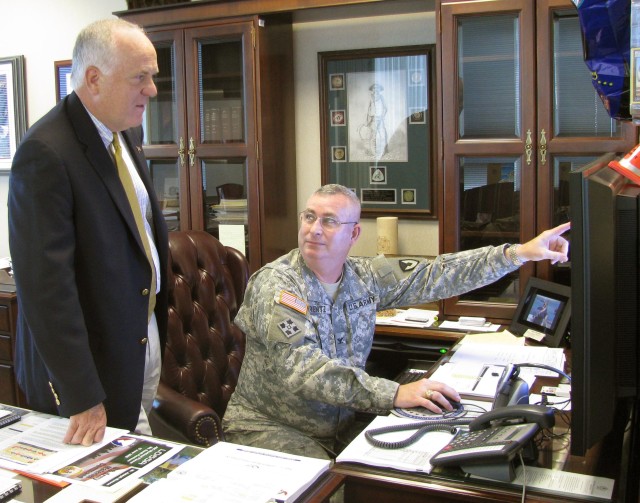The Logistics Support Activity does just what its name implies.
LOGSA helps a multitude of other organizations work more efficiently by collecting, storing and organizing data.
"We are the Army's single authoritative database for logistics," commander Col. James Rentz said. "We do enterprise level analytics across the Army in many different spectrums -- supply, maintenance, distribution, transportation and finance. We take data from all of the standard Army management information systems."
LOGSA was formed as part of a base realignment and closure action in 1993. It took several logistic support activities and components and consolidated them under one roof.
"It brought several different activities across the United States here together at Huntsville, Ala.," Richard Manley, LOGSA chief of enterprise integration center, said.
LOGSA collects information from other offices, depots and organizations involved in military materiel, equipment and life cycle management.
"We connect the dots," Rentz said. "We have to make sure that what we do in this system feeds the other systems that need the information, so that we get a holistic and complete circle."
They then organize and package that information into databases, the largest of which is the Logistics Information Warehouse. Those databases are electronically accessible by authorized users globally. Within those databases resides in-depth information about every step in a system or component's life. LOGSA offers more than 5 billion data records. They have 10,000 reference tables. Trying to use such a vast resource can be intimidating, so LOGSA has developed many different user interfaces and tools so that the system is customized to the needs of each user. LOGSA databases have 92,396 registered users.
Having such a reference a click away allows for the most accurate tracking of costs, shipping timelines and mission readiness available.
"We can tell the Department of the Army 'Here is what it costs to do business. Here is what you can do to improve business.' We feed into the readiness cycle," Rentz said.
The databases are in high demand. LOGSA is handling 6 to 12 million transactions a day globally. The software and programs required for the amount and type of business are done in-house, mostly by contractor programmers and IT professionals.
"I tell people that we're not an IT shop," Manley said. "But IT enables us. We have a robust mid-tier architecture and we have some very robust automated tools that people use from Department of the Army all the way down to the unit level."
LOGSA employs 223 contractors, about 350 civilian logisticians and 22 servicemembers. The bulk of its work force is located in Sparkman Center building 5307. It also has components worldwide, including lab facilities designed to gather additional information. One of which, located at Tobyhanna Army Depot, Pa., focuses on packaging, storage and containerization.
"There is a $20 million lab there that does testing for all branches of service," Rentz said. "They do a lot of reimbursable work for other federal agencies."
LOGSA also manages the oil analysis operation. Through analysis data, acquisition centers, project offices and other organizations are able to better anticipate equipment life and parts requirements.
"You can look for trends, like geographical area, that are causing components to fail," Rentz said. "They use the lab data to try and figure out how to extend the life of components or make them function better."
The organization does more than manage information. LOGSA also produces several technical publications. They offer 12,500 equipment technical manuals online and more than 120 weapon system CDs. They put together Soldier guides to help war fighters at the unit level understand and make the most of LOGSA's tools and products.
They also publish 65,000 issues of PS Magazine monthly. It discusses current equipment and maintenance issues at a level that will be of interest and benefit to Soldiers in the field.
"There is only one thing that has been constant for me in my 28 years in the Army," Rentz said. "It's called PS Magazine. It's designed to help that sergeant first class, staff sergeant or sergeant sitting down in a unit motor pool. They've got muddy boots, greasy hands and they're turning wrenches all day long. It's to help them do their job better."
The publication is put together from suggestions and questions from Soldiers returning from deployment. LOGSA collects the information, formulates the answers from actual data and pairs it with quality graphics to make an entertaining and informative source for Soldiers.
"We're probably the only entity in the Army with a contract with a cartoonist," Manley said.
LOGSA also plays a role in the creation of standards at the Department of Defense and international levels. Often, that includes modifying their existing products, allowing access by foreign sales users without compromising American security.
"We negotiate crossover agreements with them to use our products," Rentz said.
LOGSA recently added another service to its menu. The Core Theater Area Support Computing Center has been centralized within LOGSA. It operates continuously 24 hours a day, seven days a week.
"Every supply requisition that a unit issues flows through that room downstairs," Manley said. "It is the system that keeps the tactical operational Army going."


Social Sharing